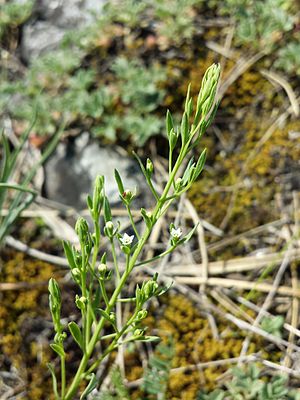Branched flax leaf
| Branched flax leaf | ||||||||||||
|---|---|---|---|---|---|---|---|---|---|---|---|---|

Flax leaf ( Thesium ramosum ) |
||||||||||||
| Systematics | ||||||||||||
|
||||||||||||
| Scientific name | ||||||||||||
| Thesium ramosum | ||||||||||||
| Hayne |
The branchy linseed leaf ( Thesium ramosum Hayne ; Syn .: Thesium arvense Horv. , Nom. Illeg.), Also called branchy flax leaf , is a species of the sandalwood family (Santalaceae).
description
Vegetative characteristics
The Ästig-Leinblatt is a perennial herbaceous plant that usually reaches heights of 15 to 25 centimeters. The linear to linear-lanceolate, simple, undivided and full-margined leaves are arranged alternately and have one and, in rarer cases, three leaf veins .
Generative characteristics
The flowering time of the branch linseed leaves in Central Europe from May to August. The inflorescence is a raceme . The 5 to 15 millimeter long peduncle has three bracts at its upper end, directly below the flower : a bract , the stem of which is recurrently fused with the peduncle , and two significantly shorter prophylls on the side . The free blade of the bract is about as long as the flower or bract stem.
The hermaphrodite flowers have an overgrown, radially symmetrical perigone with a diameter of 3 to 4 millimeters, which has five, sometimes only four, tips that are white on the inside and green on the outside. At the time of fruiting, the perigone curls up to the bottom. The flower has four or five stamens and under constant ovary with a stylus on. The longitudinally veined fruits are about 1.25 to 5 millimeters long. The rolled up perigone is about a quarter of the length of the fruit.
ecology
The branchy flax leaf is a hemicryptophyte . The species is a semi-parasite : the roots of the flax leaf tap into the roots of host plants by means of suction cups ( haustoria ) and remove nutrients from them .
Occurrence and endangerment
The Ästig flax leaf occurs in Europe in East Central and Eastern Europe . In the German-speaking area, the species is indigenous only in Austria .
In Austria, the Ästig flax leaf occurs in the Pannonian flora province scattered or rarely, otherwise very rarely on dry grass and fallow fields in the colline altitude . The occurrences are limited to the federal states of Vienna , Lower Austria , Burgenland and Upper Austria (the latter only inconsistent). The species is considered endangered.
Individual evidence
- ↑ a b Entry at The Euro + Med PlantBase - the information resource for Euro-Mediterranean plant diversity
- ↑ a b c d e f Manfred A. Fischer, Karl Oswald, Wolfgang Adler: Excursion flora for Austria, Liechtenstein and South Tyrol . 3rd, improved edition. Province of Upper Austria, Biology Center of the Upper Austrian State Museums, Linz 2008, ISBN 978-3-85474-187-9 , p. 387 .

